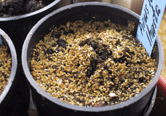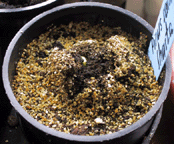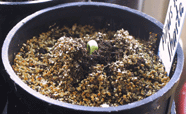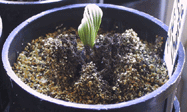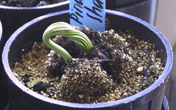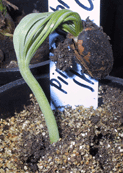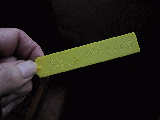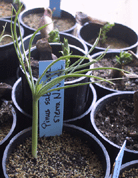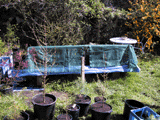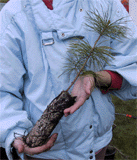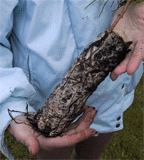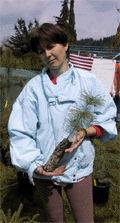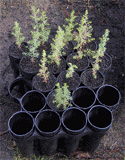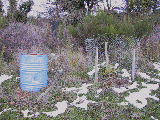1
Seeds just taken out of the refrigerator.
Two seeds are germinating.
18 January 2004
|
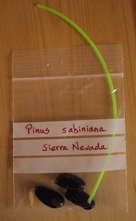
| Pre-treatment : when the seeds are fresh, usually no pre-treatment is required.
Most fertile seeds will germinate without problem.
When the frost period is over, begin to sow outside, allowing the seeds to be exposed to temperature variations between day and night.
Some seeds will germinate better with low temperatures (below 20°C - especially Abies and Cedrus seeds).
Some genera like Taxus and Juniperus can germinate already the first year, but more often or more regularly the second year.
A better control of germination can be carried by a cold pre-treatment.
It is also advisable for stored seeds.
In that case I will recommand a nude stratification.
This method will avoid as much as possible contamination by bacteria or fungi.
After soaking the seeds in water, surface dry the seeds roughly and put them in a plastic zip-bag and in the refrigerator at a temperature below 5°C.
A thin tube will allow gaz exchanges (avoiding an anaerobic confinement - see photo).
Check every week for seeds beginning to germinate.
When it is happening, take the seed out and sow it preferably at a temperature not below 20°C, in an acidic medium to avoid fungi (but no peat moss, please).
Ungerminating seeds can stay in the refrigerator for several weeks or can be sowed right away after 3 or 4 weeks.
This method (keeping the seeds in the refrigerator) is working fine with Cupressus, Juniperus (the later seeds germinating up to one year after being placed in the refrigerator).
For the most difficult seeds, after a few weeks, take them out of the refrigerator, let them dry at room temperature for a few days.
Then there is an alternative: to store them half-dry in the refrigerator again for a later use (if the growing season is over, for instance), or re-soak them and repeat the previous treatment.
The Pinus sabiniana seeds on the photo had this very treatment after a few years of storage.
|
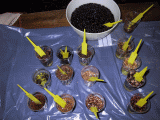
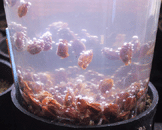 The first step is to soak the seeds in tap water.
Every seed species is put in a plastic glass and recovered with water for 24-48 hours.
Usually viable seeds will fall to the bottom of the glass within 24 hours at room temperature.
Empty seeds will be floating (Pinus, Abies, Picea, Torreya, Taxus, etc.).
It is easy to cut some seeds to verify; then the floating empty seeds can be discarded.
On the photo on the right, bubbles are appearing at the surface of the seedcoats.
It is the best evidence of fresh seeds chemical activity.
The small bubbles are pulling some seeds upwards.
The first step is to soak the seeds in tap water.
Every seed species is put in a plastic glass and recovered with water for 24-48 hours.
Usually viable seeds will fall to the bottom of the glass within 24 hours at room temperature.
Empty seeds will be floating (Pinus, Abies, Picea, Torreya, Taxus, etc.).
It is easy to cut some seeds to verify; then the floating empty seeds can be discarded.
On the photo on the right, bubbles are appearing at the surface of the seedcoats.
It is the best evidence of fresh seeds chemical activity.
The small bubbles are pulling some seeds upwards.

